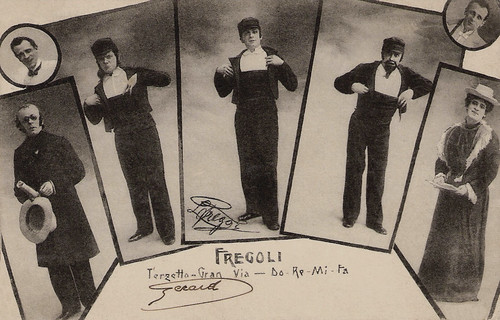
Italian postcard by Garzini & Pezzini, Milano, 1903. This postcard was sent in 1905 within Belgium from Dolhain (Limburg) to Anvers (Antwerp).
Leopoldo Fregoli (1867-1936) was one of the first vaudeville artists to use film. Fregoli was famous for his rapid transformation acts, in which he did impersonations of famous artistic and political characters. After a visit to Lyon, Fregoli bought a Cinématographe from the Lumière brothers in 1898. He started to show shorts, named 'Fregoligraph', as part of his stage act. He soon learned the possibilities of film trickery and began to employ surprise cuts and reverses. Among his Italian films were Maestri di musica, in which Fregoli impersonated a variety of composers including Verdi, Wagner, and Rossini, Fregoli illusionista, and Fregoli dietro le scene. His filming was, however, only a brief interlude in an international stage career that lasted many years. The Roman Centro Sperimentale di Cinematografia holds several of Fregoli's short films, which therefore belong to the oldest surviving Italian film material.

Italian postcard by V. Uff. Rev. St. Terni / IPA CT Duplex, no. 5897. Photo: Fot. Comerio, Milano.
Edoardo Ferravilla (1846-1915) was a Milanese actor and playwright of the Italian stage and silent screen, who performed in Milanese dialect. In 1870 he was discovered as an actor by Cletto Arrighi, founder of the Teatro Milanese. He made his debut in the comedy 'El Barchett de Boffalora', which would be staged hundreds of times. He soon became the darling of the Italian public and created a series of very important characters: Massinelli, El sciur Pànera, Gigione, Master Pastizza, and Tecoppa. These characters he also performed in cinema in comedy shorts shot between 1913 and 1915, first at Mediolanum Film and then at Comerio Films.

French postcard, no. 3. Cliché X.
André Deed (1879-1940) was one the most popular comedians in French and Italian silent cinema under the names of Boireau and Cretinetti. Deed started his career around 1900 as a circus acrobat and music-hall singer. In 1901 he did his first steps in the movie world in supporting roles, working for film pioneer Georges Méliès. In 1906 he started his own series of short comedies at Pathé Frères, around a comic character designed by himself: Boireau. Because of the huge popularity of the Boireau comedies, in 1908 the Torinese company Itala lured him to Italy, where Deed started the series of Cretinetti [which more or less stands for ‘little stupid’]. He not only acted but also directed his own films now. Just like in the French films, Deed behaved in a quite anarchic way, creating destruction and pursuits all over. Between 1909 and 1911 and between 1915 and 1920 Deed interpreted some 90 shorts with Cretinetti.
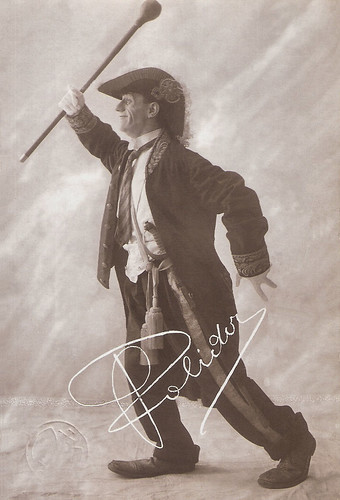
Italian postcard by Tip. Sent by mail in 1922.
Ferdinand Guillaume (1887-1977) was an Italian comical actor, famous in the 1910s as Tontolini and Polidor. In 1910, the Cines company launched him as the character Tontolini, also known in Britain and the US as 'Jenkins'. Guillaume provided Cines and Italy an international reputation in the field of comical films. His circus background was a clear consistency in his films. After some 100 shorts as Tontolini, and after the success of his first feature-length film, Pinocchio (Giulio Antamoro, 1911), Ferdinand Guillaume went over to the Pasquali company. Here he created the character of Polidor (named after a horse in his previous circus shows), continuing his double profession of leading actor and director, being often the scriptwriter of his films too. Shooting some 100 films, up to four films a month, in the years 1912-1914, the Polidor films were distributed all over Europe and the US.

Italian postcard by Roseo & C., Napoli. Collection: Joseph North.

Italian postcard by Uff. Rev. St. Terni. Photo: Lea Giunchi in Quo Vadis? (Enrico Guazzoni, 1913). Lygia (Giunchi) saves Vinicius (Amleto Novelli) from the hands of Ursus (Bruto Castellani). Ursus, the protector of Lygia, has just killed a gladiator who had been charged by Vinicius to kill Ursus while he himself planned to abduct Licia.
Lea Giunchi (1884-?) was the first comical actress in Italian cinema, acting either in her own 'Lea' series or with male comedians such as Ferdinand Guillaume (Tontolini) and Raymond Frau (Kri Kri). She also played in the Italian silent epic Quo Vadis? (1913), modern dramas, and action movies.
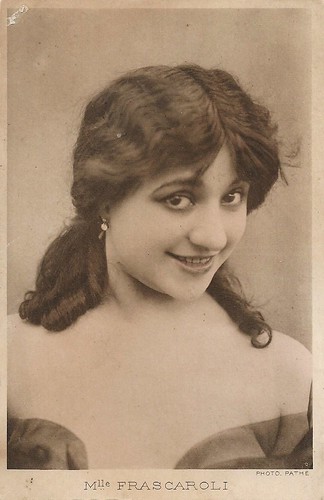
French postcard. Photo: Pathé. Caption: M[ademoise]lle Frascaroli.
Valentina Frascaroli (1890-1955) was an Italian actress on the silent screen. After training in dance and acting, she performed on stage. In 1909 she was hired by Itala Film, first as a screenwriter, then as an actress. At Itala, she became the beloved companion of former Pathé comedian André Deed, known in Italy as 'Cretinetti' and in France as 'Gribouille'. She followed him to France when he returned to Pathé, now as 'Boireau'. Frascaroli also had her own comedies there.
In his article 'All the same or Strategies of Difference. Early Italian Comedies in International Perspective', Ivo Blom writes: "In the past, scholars discussed comedians as if they were all the same. But every comedian represents his/her own type.
Differences not only in physical appearance and performance but also in content, style, and professional background can be traced as much between Cretinetti and Polidor as between Kri Kri and Robinet. Furthermore, a clear difference exists between the comedies performed by these comedians and those of Gigetta, Rodolfi, Vaser, and Pilotti.
The latter ones are more boulevardier-like, “with their stories of dreadful wives, nasty mothers-in-law, and depressed husbands”, as Vittorio Martinelli has remarked. Martinelli has argued that in early Italian cinema there are two kinds of comedies, divided by a phenomenon that can also be traced in other national cinemas: the development of comedy from vaudeville and the circus, and the development of comedy from the legitimate theatre.
We could dub this distinction as the opposition between the more action-driven comedy or comiche and the situation comedy, or commedie, often centered on a domestic theme. Comedies tied to vaudeville and the circus diminished drastically in European cinema after the early teens, while the latter type continued as a quantitatively minor, but no less interesting, genre.
With the arrival of the long movie, comedies linked to legitimate theatre became an important genre in both Europe and the United States."
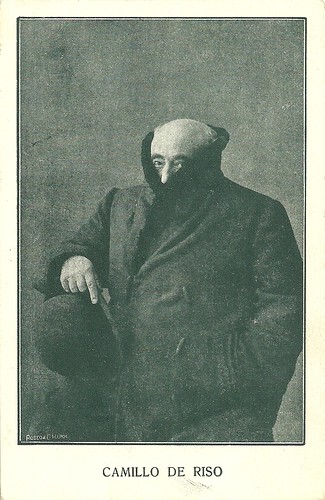
Italian postcard by Magazine Film - corriere dei cinematografici, Napoli/Roma. Photo: Roseo & Co, Naples / Caesar Film.
Camillo De Riso (1854-1924) was an Italian actor and director of the Italian stage and screen, most famous for his comic acting and directing at the companies Ambrosio, Gloria, and Caesar.

Italian postcard. G.B. Falci, Milano, no. 1920s. Emilio Vardannes (left) as the Inquisitor Stefano Donato with Biancamaria Hubner as Saita in La congiura di San Marco (Domenico Gaido, 1924), the sequel to Il ponte dei sospiri (Domenico Gaido, 1921).
Émile or Emilio Vardannes (1873-1951) was a French actor, director, and screenwriter, who had a prolific career in Italian silent cinema. In 1909, when he was hired as an actor and film director by the Pasquali company, Vardannes was already an established and experienced theatre actor. In 1911 he was hired by Itala Film, where he starred in and directed the Totò comedy series which he had already started at Pasquali. In 1912, Vardannes moved on to Milano Films where he starred in a comedy series as a new character named Bonifacio. He returned to Itala Film in 1913, where he was employed not only as a comedian but also as a dramatic actor.

Italian postcard. Photo: Cine. Film still for the classic epic Quo Vadis? (Enrico Guazzoni, 1913). Caption: A banquet on the Palatine. The fat and drunken man in front is Giuseppe Gambardella.
Italian actor Giuseppe Gambardella (1880-circa 1950) was famous as Checco in short silent Italian comedies. In 1909 he debuted in the cinema when he was hired by Cines in Rome. With his robust physique and face full of surprise, he was the opposite of the typical hysterical, angry comics of Italian cinema of those years. He was the sidekick to Tontolini (Ferdinand Guillaume), Lea (Lea Giunchi), Cocò (Pacifico Aquilanti / Lorenzo Soderini), little Cinessino (Eraldo Giunchi) and Kri Kri (Raymond Dandy). In 1912 he created his own character of Checco, often paired with Soderini as Cocò. Sometimes he had lead roles such as in Il re della moda (1914) and Il candidato (1914). In Spain, Checco was called 'Pancho', in France Grosventre, in Britain 'Stout'. He was also a comical sidekick in feature-length films such as the epic Quo Vadis? (Enrico Guazzoni, 1913).

Italian postcard by Fotocelere.
Italian actress Luigia 'Gigetta' Morano (1887–1986) was very popular in the early 1910s as a comedian at the Ambrosio film studio, where she had started in 1908. She had her own comic series with the type Gigetta. Together with Eleuterio Rodolfi, her partner on-screen and her most prolific director, she did countless comedies, both shorts, and longer films. Before 1910 Ambrosio produced only a dozen comedies each year without a focus on a particular performer. In 1910, the company decided to expand its production, going from 16 comedies in 1909 and 43 in 1910 to 60 in 1911 and 77 in 1912. Following the style of the Itala Film, which had success with the character of Cretinetti, Ambrosio developed similar characters. These included Fricot and Robinet, the latter trusted to the Spanish actor Marcel Fabre a.k.a. Marcel Perez. Ambrosio sensed they also had to add a female comic character to the already known male ones and this is how Morano became, as 'Gigetta', the first comic actress of Italian cinema.
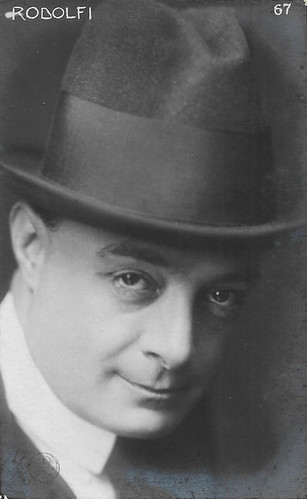
Italian postcard, no. 67. Photo: G. Vettori, Bologna.
Italian actor, director, and scriptwriter Eleuterio Rodolfi (1876-1933) was highly active in Italian silent cinema. For Ambrosio, Rodolfi acted in some 95 films of which some 80 were directed and scripted by himself. Many of these were comedies interpreted by Rodolfi together with actress Gigetta Morano, and they became known as ‘Gigetta’ and ‘Rodolfi’. In contrast to the previous anarchist farces by Cretinetti and others, who focused on speed and havoc, entitled as ‘comiche’ in Italian, the comedies with Gigetta and Rodolfi were true ‘commedie’, so more situational, boulevardier, less speedy, and often hinting at forbidden fruits and voyeurism.

Italian postcard by Ballerini & Fratini, Florence, no. 31. Photo: Scoffone.
Italian stage and film actor Oreste Bilancia (1881-1945) was highly active in Italian silent and sound cinema and also in the late silent cinema of the Weimar republic. In 1914 the Turin-based film production company Ambrosio engaged him as a film actor. The rotund Bilancia, often wearing a monocle, represented the bon vivant and gentleman in many Italian silent films.

Italian postcard by Ed. A. Traldi, Milano, no. 71. Domenico Gambino as Saetta in (probably) Caporal Saetta (Eugenio Perego, 1924).
Domenico Maria Gambino (1891-1968) was well-known as the acrobatic comedian Saetta and he often wrote, directed, and produced his own films. According to Vittorio Martinelli, one day in 1908 Gambino saw a shooting on location by the Itala film company and noticed an actor who had fallen from a coach and was not eager to repeat this. Gambino offered to replace him. Between 1910 and 1916 Gambino worked for the Itala company, appearing as extra in the comedies with Cretinetti (André Deed) and in comedies with other actors, often dressing up as women. In 1911 he started his own comic series of Saltarelli, starting with Saltarelli ha fatto bagno nel caucciù (1911), followed by Vista corta, ma testa dura (1912). He also appeared with Emilio Vardannes (Totò) in the comedy Più forte che Sherlock Holmes (Giovanni Pastrone, 1913) and in André Deed’s La paura degli aeromobili nemici (André Deed, 1915). In 1918 Gambino founded his own film company Delta Film and started interpreting a new comic character, named Saetta by his regular scriptwriter Fantasio (Riccardo Artuffo). Saetta protects the good people against the evil ones, often helped by his animals (dogs, monkeys, etc.). As a true acrobat, he is specialised in climbing facades and doing daredevil jumps, meticulously preparing his stunts. Despite the crisis in Italian cinema in the 1920s, he managed to make several films each year.

Italian postcard by Ed. G.B. Falci, Milano, no. 206. Pina Menichelli and Marcel Lévesque in La dame de Chez Maxim's (1923).
La dame de Chez Maxim's (Amleto Palermi 1923) was one of Pina Menichelli's last films. With this film and with Occupati d'Amelia (Telemaco Ruggeri 1925), adaptations of two popular Georges Feydeau boulevard comedies, Menichelli proved she was well able to do comedy and not only melodramatic and 'vampy' films. In both films, one of her co-stars was the French comedian Marcel Levésque, on the far right on this card. In the middle Ugo Gracci as Petypon. After these comedies, however, Menichelli married an aristocrat and film producer, withdrew from cinema, and held back any attempt to interview her.

Dutch postcard by Eye Filmmuseum. Italian poster for Kri-Kri e Lea militari (Cines, 1913). Postcard of a poster in the Collection Desmet, issued in 2014 when Eye uploaded some 900 images of posters in the Desmet Collection to the European Film Gateway 1914 website. The original design of the poster was by Romeo Marchetti (1876-1940), who for several years designed all the Cines film posters on the comic characters of Kri-Kri (Raymond Frau) and Lea (Lea Giunchi).
Source: Ivo Blom, All the same, or Strategies of Difference. Early Italian Comedies in International Perspective, in 'Italian Silent Cinema: A Reader', Edited by Giorgio Bertellini.

Italian postcard by V. Uff. Rev. St. Terni / IPA CT Duplex, no. 5897. Photo: Fot. Comerio, Milano.
Edoardo Ferravilla (1846-1915) was a Milanese actor and playwright of the Italian stage and silent screen, who performed in Milanese dialect. In 1870 he was discovered as an actor by Cletto Arrighi, founder of the Teatro Milanese. He made his debut in the comedy 'El Barchett de Boffalora', which would be staged hundreds of times. He soon became the darling of the Italian public and created a series of very important characters: Massinelli, El sciur Pànera, Gigione, Master Pastizza, and Tecoppa. These characters he also performed in cinema in comedy shorts shot between 1913 and 1915, first at Mediolanum Film and then at Comerio Films.

French postcard, no. 3. Cliché X.
André Deed (1879-1940) was one the most popular comedians in French and Italian silent cinema under the names of Boireau and Cretinetti. Deed started his career around 1900 as a circus acrobat and music-hall singer. In 1901 he did his first steps in the movie world in supporting roles, working for film pioneer Georges Méliès. In 1906 he started his own series of short comedies at Pathé Frères, around a comic character designed by himself: Boireau. Because of the huge popularity of the Boireau comedies, in 1908 the Torinese company Itala lured him to Italy, where Deed started the series of Cretinetti [which more or less stands for ‘little stupid’]. He not only acted but also directed his own films now. Just like in the French films, Deed behaved in a quite anarchic way, creating destruction and pursuits all over. Between 1909 and 1911 and between 1915 and 1920 Deed interpreted some 90 shorts with Cretinetti.

Italian postcard by Tip. Sent by mail in 1922.
Ferdinand Guillaume (1887-1977) was an Italian comical actor, famous in the 1910s as Tontolini and Polidor. In 1910, the Cines company launched him as the character Tontolini, also known in Britain and the US as 'Jenkins'. Guillaume provided Cines and Italy an international reputation in the field of comical films. His circus background was a clear consistency in his films. After some 100 shorts as Tontolini, and after the success of his first feature-length film, Pinocchio (Giulio Antamoro, 1911), Ferdinand Guillaume went over to the Pasquali company. Here he created the character of Polidor (named after a horse in his previous circus shows), continuing his double profession of leading actor and director, being often the scriptwriter of his films too. Shooting some 100 films, up to four films a month, in the years 1912-1914, the Polidor films were distributed all over Europe and the US.

Italian postcard by Roseo & C., Napoli. Collection: Joseph North.

Italian postcard by Uff. Rev. St. Terni. Photo: Lea Giunchi in Quo Vadis? (Enrico Guazzoni, 1913). Lygia (Giunchi) saves Vinicius (Amleto Novelli) from the hands of Ursus (Bruto Castellani). Ursus, the protector of Lygia, has just killed a gladiator who had been charged by Vinicius to kill Ursus while he himself planned to abduct Licia.
Lea Giunchi (1884-?) was the first comical actress in Italian cinema, acting either in her own 'Lea' series or with male comedians such as Ferdinand Guillaume (Tontolini) and Raymond Frau (Kri Kri). She also played in the Italian silent epic Quo Vadis? (1913), modern dramas, and action movies.

French postcard. Photo: Pathé. Caption: M[ademoise]lle Frascaroli.
Valentina Frascaroli (1890-1955) was an Italian actress on the silent screen. After training in dance and acting, she performed on stage. In 1909 she was hired by Itala Film, first as a screenwriter, then as an actress. At Itala, she became the beloved companion of former Pathé comedian André Deed, known in Italy as 'Cretinetti' and in France as 'Gribouille'. She followed him to France when he returned to Pathé, now as 'Boireau'. Frascaroli also had her own comedies there.
Dreadful wives, nasty mothers-in-law, and depressed husbands
In his article 'All the same or Strategies of Difference. Early Italian Comedies in International Perspective', Ivo Blom writes: "In the past, scholars discussed comedians as if they were all the same. But every comedian represents his/her own type.
Differences not only in physical appearance and performance but also in content, style, and professional background can be traced as much between Cretinetti and Polidor as between Kri Kri and Robinet. Furthermore, a clear difference exists between the comedies performed by these comedians and those of Gigetta, Rodolfi, Vaser, and Pilotti.
The latter ones are more boulevardier-like, “with their stories of dreadful wives, nasty mothers-in-law, and depressed husbands”, as Vittorio Martinelli has remarked. Martinelli has argued that in early Italian cinema there are two kinds of comedies, divided by a phenomenon that can also be traced in other national cinemas: the development of comedy from vaudeville and the circus, and the development of comedy from the legitimate theatre.
We could dub this distinction as the opposition between the more action-driven comedy or comiche and the situation comedy, or commedie, often centered on a domestic theme. Comedies tied to vaudeville and the circus diminished drastically in European cinema after the early teens, while the latter type continued as a quantitatively minor, but no less interesting, genre.
With the arrival of the long movie, comedies linked to legitimate theatre became an important genre in both Europe and the United States."

Italian postcard by Magazine Film - corriere dei cinematografici, Napoli/Roma. Photo: Roseo & Co, Naples / Caesar Film.
Camillo De Riso (1854-1924) was an Italian actor and director of the Italian stage and screen, most famous for his comic acting and directing at the companies Ambrosio, Gloria, and Caesar.

Italian postcard. G.B. Falci, Milano, no. 1920s. Emilio Vardannes (left) as the Inquisitor Stefano Donato with Biancamaria Hubner as Saita in La congiura di San Marco (Domenico Gaido, 1924), the sequel to Il ponte dei sospiri (Domenico Gaido, 1921).
Émile or Emilio Vardannes (1873-1951) was a French actor, director, and screenwriter, who had a prolific career in Italian silent cinema. In 1909, when he was hired as an actor and film director by the Pasquali company, Vardannes was already an established and experienced theatre actor. In 1911 he was hired by Itala Film, where he starred in and directed the Totò comedy series which he had already started at Pasquali. In 1912, Vardannes moved on to Milano Films where he starred in a comedy series as a new character named Bonifacio. He returned to Itala Film in 1913, where he was employed not only as a comedian but also as a dramatic actor.

Italian postcard. Photo: Cine. Film still for the classic epic Quo Vadis? (Enrico Guazzoni, 1913). Caption: A banquet on the Palatine. The fat and drunken man in front is Giuseppe Gambardella.
Italian actor Giuseppe Gambardella (1880-circa 1950) was famous as Checco in short silent Italian comedies. In 1909 he debuted in the cinema when he was hired by Cines in Rome. With his robust physique and face full of surprise, he was the opposite of the typical hysterical, angry comics of Italian cinema of those years. He was the sidekick to Tontolini (Ferdinand Guillaume), Lea (Lea Giunchi), Cocò (Pacifico Aquilanti / Lorenzo Soderini), little Cinessino (Eraldo Giunchi) and Kri Kri (Raymond Dandy). In 1912 he created his own character of Checco, often paired with Soderini as Cocò. Sometimes he had lead roles such as in Il re della moda (1914) and Il candidato (1914). In Spain, Checco was called 'Pancho', in France Grosventre, in Britain 'Stout'. He was also a comical sidekick in feature-length films such as the epic Quo Vadis? (Enrico Guazzoni, 1913).

Italian postcard by Fotocelere.
Italian actress Luigia 'Gigetta' Morano (1887–1986) was very popular in the early 1910s as a comedian at the Ambrosio film studio, where she had started in 1908. She had her own comic series with the type Gigetta. Together with Eleuterio Rodolfi, her partner on-screen and her most prolific director, she did countless comedies, both shorts, and longer films. Before 1910 Ambrosio produced only a dozen comedies each year without a focus on a particular performer. In 1910, the company decided to expand its production, going from 16 comedies in 1909 and 43 in 1910 to 60 in 1911 and 77 in 1912. Following the style of the Itala Film, which had success with the character of Cretinetti, Ambrosio developed similar characters. These included Fricot and Robinet, the latter trusted to the Spanish actor Marcel Fabre a.k.a. Marcel Perez. Ambrosio sensed they also had to add a female comic character to the already known male ones and this is how Morano became, as 'Gigetta', the first comic actress of Italian cinema.

Italian postcard, no. 67. Photo: G. Vettori, Bologna.
Italian actor, director, and scriptwriter Eleuterio Rodolfi (1876-1933) was highly active in Italian silent cinema. For Ambrosio, Rodolfi acted in some 95 films of which some 80 were directed and scripted by himself. Many of these were comedies interpreted by Rodolfi together with actress Gigetta Morano, and they became known as ‘Gigetta’ and ‘Rodolfi’. In contrast to the previous anarchist farces by Cretinetti and others, who focused on speed and havoc, entitled as ‘comiche’ in Italian, the comedies with Gigetta and Rodolfi were true ‘commedie’, so more situational, boulevardier, less speedy, and often hinting at forbidden fruits and voyeurism.

Italian postcard by Ballerini & Fratini, Florence, no. 31. Photo: Scoffone.
Italian stage and film actor Oreste Bilancia (1881-1945) was highly active in Italian silent and sound cinema and also in the late silent cinema of the Weimar republic. In 1914 the Turin-based film production company Ambrosio engaged him as a film actor. The rotund Bilancia, often wearing a monocle, represented the bon vivant and gentleman in many Italian silent films.

Italian postcard by Ed. A. Traldi, Milano, no. 71. Domenico Gambino as Saetta in (probably) Caporal Saetta (Eugenio Perego, 1924).
Domenico Maria Gambino (1891-1968) was well-known as the acrobatic comedian Saetta and he often wrote, directed, and produced his own films. According to Vittorio Martinelli, one day in 1908 Gambino saw a shooting on location by the Itala film company and noticed an actor who had fallen from a coach and was not eager to repeat this. Gambino offered to replace him. Between 1910 and 1916 Gambino worked for the Itala company, appearing as extra in the comedies with Cretinetti (André Deed) and in comedies with other actors, often dressing up as women. In 1911 he started his own comic series of Saltarelli, starting with Saltarelli ha fatto bagno nel caucciù (1911), followed by Vista corta, ma testa dura (1912). He also appeared with Emilio Vardannes (Totò) in the comedy Più forte che Sherlock Holmes (Giovanni Pastrone, 1913) and in André Deed’s La paura degli aeromobili nemici (André Deed, 1915). In 1918 Gambino founded his own film company Delta Film and started interpreting a new comic character, named Saetta by his regular scriptwriter Fantasio (Riccardo Artuffo). Saetta protects the good people against the evil ones, often helped by his animals (dogs, monkeys, etc.). As a true acrobat, he is specialised in climbing facades and doing daredevil jumps, meticulously preparing his stunts. Despite the crisis in Italian cinema in the 1920s, he managed to make several films each year.

Italian postcard by Ed. G.B. Falci, Milano, no. 206. Pina Menichelli and Marcel Lévesque in La dame de Chez Maxim's (1923).
La dame de Chez Maxim's (Amleto Palermi 1923) was one of Pina Menichelli's last films. With this film and with Occupati d'Amelia (Telemaco Ruggeri 1925), adaptations of two popular Georges Feydeau boulevard comedies, Menichelli proved she was well able to do comedy and not only melodramatic and 'vampy' films. In both films, one of her co-stars was the French comedian Marcel Levésque, on the far right on this card. In the middle Ugo Gracci as Petypon. After these comedies, however, Menichelli married an aristocrat and film producer, withdrew from cinema, and held back any attempt to interview her.

Dutch postcard by Eye Filmmuseum. Italian poster for Kri-Kri e Lea militari (Cines, 1913). Postcard of a poster in the Collection Desmet, issued in 2014 when Eye uploaded some 900 images of posters in the Desmet Collection to the European Film Gateway 1914 website. The original design of the poster was by Romeo Marchetti (1876-1940), who for several years designed all the Cines film posters on the comic characters of Kri-Kri (Raymond Frau) and Lea (Lea Giunchi).
Source: Ivo Blom, All the same, or Strategies of Difference. Early Italian Comedies in International Perspective, in 'Italian Silent Cinema: A Reader', Edited by Giorgio Bertellini.
No comments:
Post a Comment